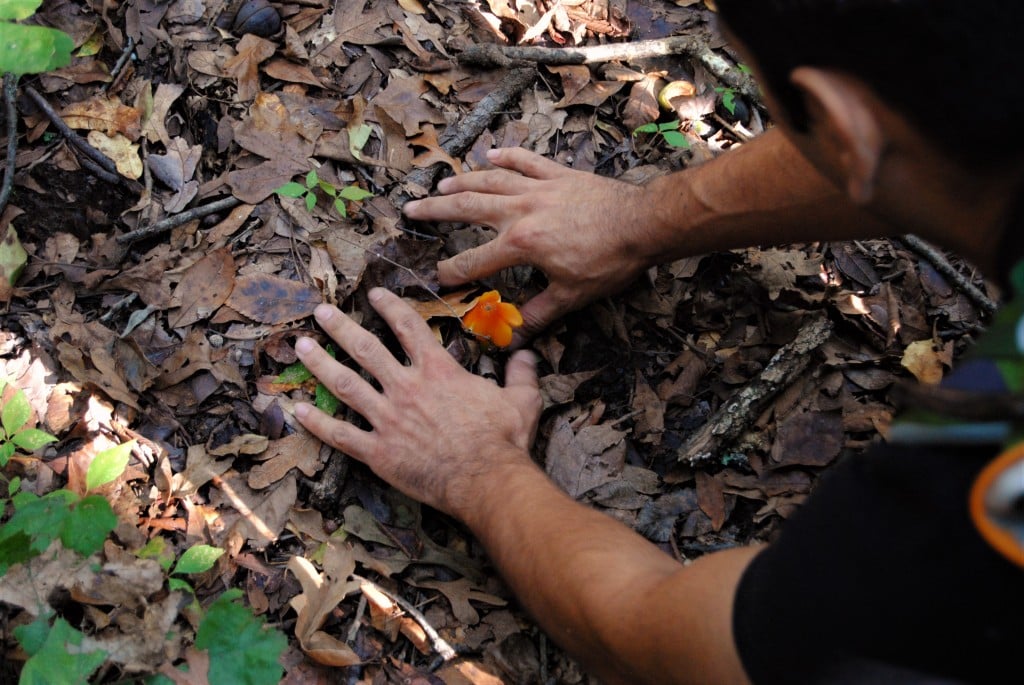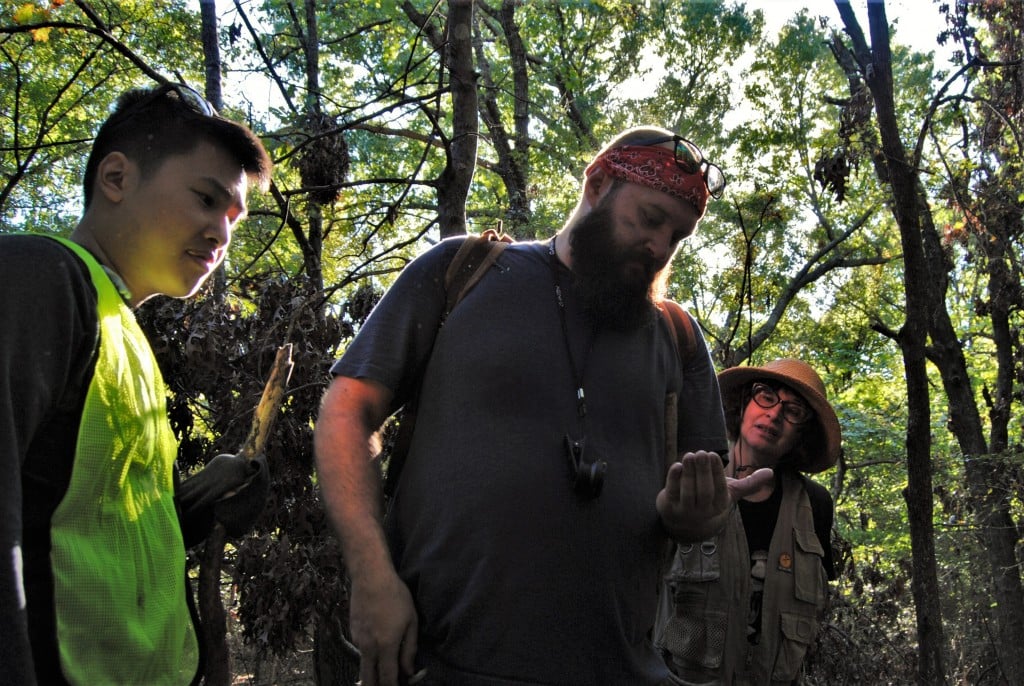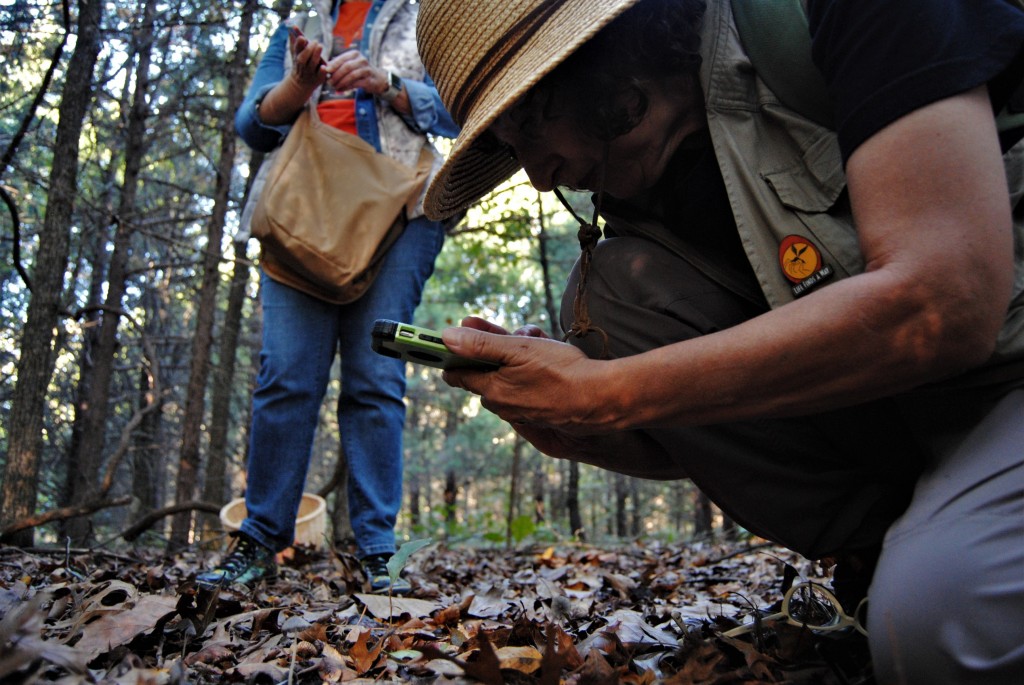Eager to go mushroom hunting in North Texas? Here’s some advice from the pros
ArtandSeek.net November 15, 2021 62Mushroom foraging can be pretty intimidating for a beginner. Where should you look? Can you just pluck them from the ground? What if the mushroom you’ve found is poisonous? There are a lot of important factors to consider.
Luckily, novice foragers in North Texas can now tap into the collective knowledge of a new organization: the North Texas Mycological Association. Many of its members have been mushroom hunting for years, and they have a few tips for beginners.
Pull up iNaturalist
Amateur foragers use this popular app to crowdsource information about the plants, animals and fungi they discover while exploring the outdoors. Just upload a photo and share the location of the sighting, and a vast network of naturalists can help you identify any species on Earth.

Sebastian Tabibi, president of the North Texas Mycological Association, uncovers a mushroom in the forested land surrounding Lake Texoma. Photo by Miguel Perez.
“It’s not just an app,” professional forager Leah Breitenstine said. “It’s a whole community of people who are often the top experts in their field or just really enthusiastic hobbyists that are very knowledgeable, and they will identify things for you.”
The app will suggest possible species based on your photo, but other users can help confirm your ID or make another suggestion. If you’re looking for a particular species, you can also use a map feature to search for documented observations.
The app also allows you to join “Projects,” where groups of users are bound by a common goal. There are several region-specific projects like the “Birds of North Texas” and “Urban Creeks of North Texas.”
Check the weather
Mushrooms need a lot of moisture to grow, so keep an eye on the forecast in your area.
“Before I go anywhere foraging, I immediately look up the rainfall accumulation maps,” experienced forager Patrick Harris said. “I look up rain history for the last three days because the moisture is going to be where you have to go if you want to find fungi.”
While some fungi can withstand drier conditions, Harris said some of the most popular edible species, like oysters and lion’s mane, require sustained rainfall that lasts a few days. Early morning, when there’s still dew on the leaves, is the best time. The rainy days in between the first fall cooldown and the first freeze are your best chance to find some delicious fungi.
Stick to public lands or get permission
Generally speaking, gathering plants and fungi for personal use is permitted on public lands, but the rules vary by location. Foraging in Texas state parks is off limits, but you can collect mushrooms in national forests. (You cannot forage in national parks. There’s a difference!) The Caddo and Lyndon B. Johnson National Grasslands is the national forest closest to the Dallas-Fort Worth metroplex.

Bryan Tran (left), Ben Gettler and Eva Gordon examine a wild mushroom during a group foray organized by the North Texas Mycological Association. Photo by Miguel Perez.
But, it’s best to visit the websites of the parks you’re visiting for specific information on foraging rules and limits.
Texas law forbids the harvesting of plants and fungi from property you do not own without the owner’s permission. That said, it doesn’t hurt to ask. Apps like Basemap and onX can help you figure out the boundary lines between public and private property.
Pluck with confidence
Mushrooms are fairly resilient to picking. Keep in mind that the actual living organism (i.e. the mycelium) is underground, and the mushroom is more like a fruit. It wants to be plucked from the ground so that it can disseminate its spores.
“There are studies that show that chanterelles that are just plucked out of the ground, instead of cut at the base, actually perform better the next year,” Harris said.
Many foragers also carry pocket knives to slice samples off of trees or soil, as well as breathable wicker baskets to carry their delicate finds.

Eva Gordon diligently scans the forest floor to spot the tiny fungi creeping through the soil. Photo by Miguel Perez.
Take a pic
Take clear shots of your fungal discoveries from all angles. Capture the details of the top of the mushroom cap, the underside, the stipe (or stem) and, if possible, a cross-section of the specimen.
You can join Facebook groups like the Mushroom Identification Page to get help figuring out what you found. It serves a similar purpose to iNaturalist, but when it comes to potentially toxic mushrooms, the more input the better.
Be mindful
Mushroom foraging will often require you to veer off of park trails, so stay mindful of your surroundings. Learn to recognize common poisonous plants like poison ivy, Texas bullnettle and poison oak.
Breitenstine says it’s also important to respect the ecosystem around you. Don’t trample plants.
Some mushroom hunters will rake the leaves off of the forest floor to uncover mushrooms hiding underneath, but she said foragers should avoid destructive practices like that, even if they’re permitted.
“They’re getting a lot more out of their parks, and they’re starting to understand what a complete ecosystem it is,” Breitenstine said. “My wish is always that once they’re outside, they start to value it. It’s kind of like a gateway drug, and I’m trying to push people through that door for sure.”
Got a tip? Email Miguel Perez at mperez@kera.org. You can follow him on Twitter @quillindie.
Art&Seek is made possible through the generosity of our members. If you find this reporting valuable, consider making a tax-deductible gift today. Thank you.










